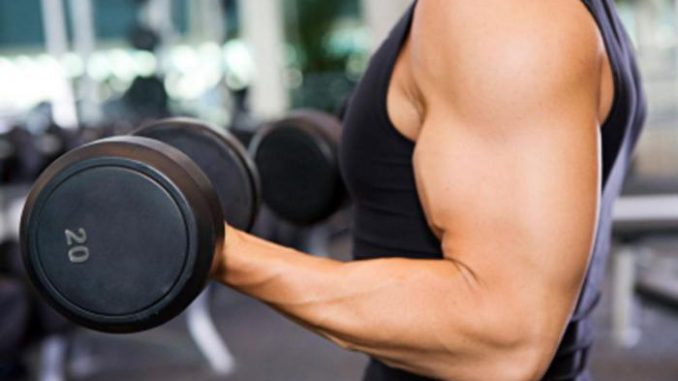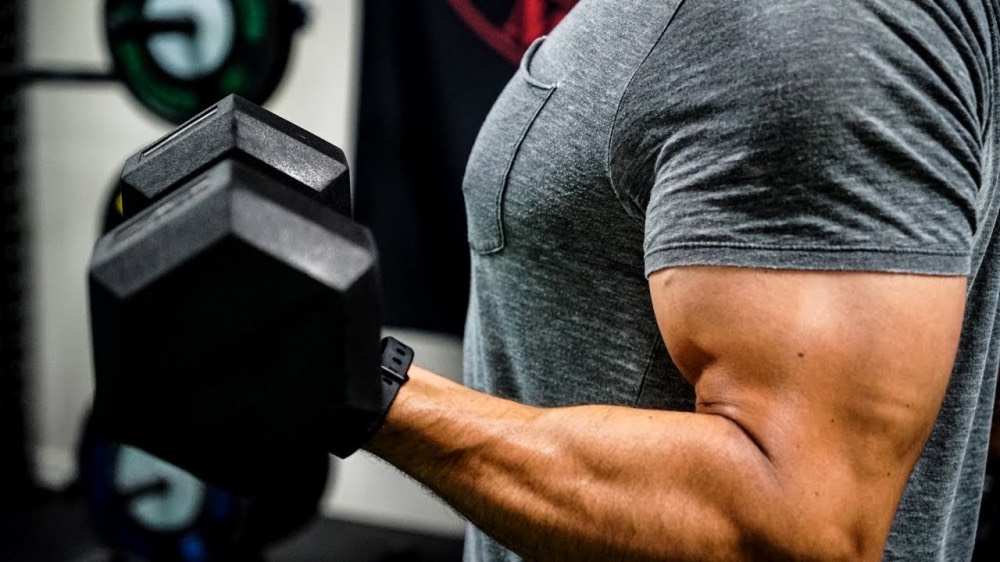
As long as you create a calorie deficit – you lose weight. We have already covered the science behind fat loss and calorie deficits in our previous article.
But the problem is that weight loss does not equal fat loss. Some of that lost weight is just water loss and some of it is, sadly, your precious muscle.
The upside is that there are many ways to minimize muscle loss while maximizing fat burn. In order to prevent muscle loss, you first need to understand how it happens.
The Difference Between Weight Loss and Fat Loss
You say your goal is to lose weight.
But is that what you really want?
If you want to lose that big fat tummy and the bulging love handles or the double chin, you want to lose fat, not just weight.
You want to lose the extra fat and build a healthy body with strong muscles. But muscle is heavier than fat and as you focus on building up your muscles, you may even see some weight gain.
Weight gain from muscles, not fat – that’s a good thing. This kind of positive weight gain is more evident in a lean person building up bulging muscles.
But for a fat person, who is working out regularly, the weight changes may be confusing.
To confirm the fat loss, you can take body measurements. The inches that are vanishing from your middle and thighs, the way the clothes are fitting better or becoming loose – these are much better indications of your fat loss progress than the weighing scale.
If you have started off on a fad diet, you will see sudden weight loss- which is mostly water weight. As you continue with the fad diet, you lose both fat and muscle which makes you weak and look haggard.
Is that what you want – just weight loss in any form? Or do you want actual fat loss that not only makes you look fabulous but also keeps you looking radiant and energetic?
Have a clear-cut understanding of your goal – and hide that weighing scale for a while.
Why Do We Lose Muscle When We Create a Caloric Deficit
A caloric deficit is created when you burn more calories than you eat [or eat fewer calories than you burn.] Your body then searches for alternative sources of energy to burn for its functions, namely the stored fats and the muscles.
The human body’s primary code is survival – it will do whatever is required to stay alive – at any cost.
If it has to sacrifice its own muscles for getting the necessary amino acids and energy fuel for the functioning of vital organs, it will do that. It doesn’t care that you want to look good, it cares more about keeping you alive.
Well, what’s the point in looking good, if you are dead?!
To understand why the muscle is broken down during a calorie deficit, you must first understand what units muscles are made up of and the role of these building blocks.
Protein Synthesis and Muscle Building

Amino acids are the smallest units of protein and they are the building blocks of the muscles in our body (1). Amino acids are divided into two groups: the essential amino acids and the non-essential amino acids.
The essential amino acids are derived from the foods we eat while the non-essential amino acids (don’t go by the name, they are also equally important) are synthesized in the body from other amino acids.
Amino acids are crucial for sustaining human health (2). They do many things including promoting the:
• Production of hormones
• Structure of muscles
• Healthy functioning of the Nervous system
• Health of vital organs
• Normal cellular structure
The protein we eat is broken down into individual amino acids in our gastrointestinal tract and these are added to the body’s amino acid pool. The amino acid pool describes the entire amount of available free amino acids in the human body.
The fate of an amino acid is highly dependent on the body’s needs at that moment. Some amino acids are used by the liver to manufacture many of the specialized proteins such as liver enzymes, lipoproteins, and blood protein.
Directed by their own DNA blueprint, each cell in the human body draws what’s necessary from the amino acid pool to synthesize the numerous proteins required for their functions.
If one or more amino acids are not available in sufficient quantities, then this protein synthesis is halted.
When there is a calorie deficit, our body’s number one priority is to obtain sufficient energy to carry on vital functions such as circulation, respiration, and digestion. It initially burns the stored fat along with small amounts of muscle tissue to provide the required fuel for the brain.
When there is a prolonged period of dietary restrictions and a deficiency of the essential amino acids, the body goes into starvation mode to conserve its remaining fat stores for survival and turns to burning lean tissue and muscle as a fuel source.
The Summary: In the absence of adequate dietary intake of proteins and energy calories, the body will break down the protein in the muscles to maintain vital organs and functions.
9 Ways to Preserve Muscle While Maximising Fat Burn
Your body or rather your brain decides on what course of action to take depending on the input or signals it receives. To improve the fat-to-muscle loss ratio as much as possible, you must send strong signals to your body to maintain your muscle and burn only the fat.
Yes! That is possible and it’s easier than you think. Hurray!
It’s just a matter of knowing which path to take and luckily for you, I’m here to light up your path and guide you all the way.
Getting straight to the point –In order to prevent muscle loss during weight loss, we have to focus on
1. Adequate Protein Ingestion
2. Resistance Exercises
Just these two things. That’s all it takes.
If it’s that simple, why do so many people keep messing it up?
Because they take the wrong paths trying to get to these destinations.

Of the 9 ways to preserve muscle while maximizing fat burn, 6 light up your pathways to ‘Adequate Protein Ingestion’, and the remaining three ensure that you execute the ‘Resistance Exercises’ correctly.
These 9 points are really enlightening for those who have repeatedly failed to maintain or build up muscle mass, despite repeated and intensive dieting and workouts.
1. Eat More Protein to Fill up the Amino Acid Pool
One of the main reasons why muscle gets broken down is for its amino acid content. So make sure your diet provides all the essential amino acids. Given below are three studies to support this fact.
1. An Italian study involving 18 obese women, observed that (3):
“Women with high-protein diet preserved lean body mass compared to a low-calorie diet and improved significant muscle strength.”
2. Research by the International Society of Sports Nutrition (ISSN) recorded that (4):
“An acute exercise stimulus, particularly resistance exercise, and protein ingestion both stimulate muscle protein synthesis and are synergistic when protein consumption occurs before or after resistance exercise.
For building muscle mass and for maintaining muscle mass through a positive muscle protein balance, an overall daily protein intake in the range of 1.4-2.0 g protein/kg body weight is sufficient for most exercising individuals, a value that falls in line with the Acceptable Macronutrient Distribution Range published by the Institute of Medicine for protein.
Higher protein intakes (2.3-3.1 g/kg body weight/day) may be needed to maximize the retention of lean body mass in resistance-trained subjects during hypocaloric periods.”
Athletes should consider focusing on whole food sources of protein that contain all of the Essential Amino acids as they are exactly what is required to stimulate muscle protein synthesis.
3. Here’s another research study about the impact of protein quality on the rates of muscle protein synthesis and loss of fat during weight loss (5). The trial concluded that:
“High-quality protein supplementation like whey protein reduced the decline in rates of Muscle Protein Synthesis after weight loss. It helps preserve lean muscle mass during longer-term weight loss programs.”
Here are some more details about the 8 essential amino acids, their functions in the human body, and their dietary sources (6).
The Summary: The first step to prevent muscle loss is to eat adequate protein in the range of 1.4-2.0 g protein/kg body weight.
2. Eat Protein Before and After your Workouts

Even if your goal is to lose body fat, you need to consume your pre and post-workout meals correctly, if you do not want to lose your muscles.
Muscle protein synthesis increases slightly after resistance workouts, while protein breakdown also increases dramatically. There is a lot more breaking down than building up.
To repair and build muscle, you must refuel with high-protein foods, as early as possible, after the workout. An intake of 20 to 40 gms of protein is sufficient to maximally stimulate muscle protein synthesis after resistance exercise (7).
The 2-hour period following your workout is often referred to as the “window of opportunity” as, during this phase, your muscles are primed to accept nutrients that can stimulate muscle repair, muscle growth, and muscle strength.
Read this post on the importance of post-workout nutrition to learn more about it and to get the science behind these claims.
The Summary: Pre and post-workout nutrition with adequate protein content are most important for improved training, fat loss, and muscle recovery.
3. A Moderate Deficit Works Better than a Large Caloric Deficit
Only a calorie deficit can lead to weight loss. That’s clear by now, I hope. If you still have any doubts about that score, go back and read “the science of fat loss.”
Now, what is the average overweight person famous for? Crash diets and complaining they don’t lose weight!
People start implementing their New Year resolutions with full enthusiasm executing fancy diet plans that create large calorie deficits.
The majority of course give up too soon to see any results at all, while the minority that stubbornly clung to their resolution for a while longer – did lose fat along with plenty of their muscle.
But, why does the majority give up?
Because their metabolism slowed down drastically. They were lethargic and always hungry. They faced problems with everything from their mood and sleep to their libido and various hormonal issues.
A large calorie deficit is difficult to sustain and it is not a healthy way to lose weight. It negatively impacts training and recovery, so you can be sure that you are going to lose plenty of muscle along with the fat if you keep it up.
The Summary: A moderate calorie deficit of about 20% less than your maintenance level is ideal for most people wanting to lose fat and save their muscles. It is sustainable and will give you steady fat loss progress without any of the undesirable effects mentioned above.
4. Calorie Cycling and Refeeds for Rapid Fat Loss
In a normal calorie-restricted diet, the same amount of calories and nutrients are consumed every day to maintain a similar-sized deficit for a certain period of time.
On a 1600-calorie diet [20% or a 400-calorie deficit for an average woman with a maintenance level of 2000 calories], the person consumes 11200 calories in a week.
On a calorie cycling diet, you switch between small deficits to larger deficits on some days and eat maintenance-level calories [no deficit] on certain days. The no deficit days can be called refeed days or even cheat days.
But at the end of the week, the total calories consumed by the individual remain the same – 11200 calories as given in the above example.
Calorie recycling is a great way to create a calorie deficit and lose fat without having to sacrifice your muscles. It does a lot of cool things including decreasing hunger, increasing satisfaction, and preventing the metabolism from slowing down due to the deficit.
Don’t just take my word for it. Here are some research studies to prove the case!
1. Researchers conducted a study using 36 overweight and sedentary women to examine the efficacy of an exercise and diet cycling program approach on weight loss, fat loss, and resting energy expenditure (8). The study concluded that:
“Short-term diet cycling during a weight loss and exercise program may be an effective way to promote weight loss without an associated reduction in basal metabolism”.
2. Another compared calorie cycling with classic calorie restriction on weight loss in overweight and obese subjects (9).
After four weeks of treatment, significant weight and fat loss started (6.02 and 5.15 kg) and continued for 1 month of follow-up (5.24 and 4.3 kg)
The resting metabolic rate tended to remain unchanged.
The decrease in plasma glucose, total cholesterol, and triacylglycerol was greater among subjects on the calorie-cycling diet.
The feeling of hunger decreased and satisfaction increased among those on the calorie cycling diet after 4 weeks.
The Summary: Calorie recycling is a great way to create a calorie deficit and lose fat without having to sacrifice your muscles. You switch between small deficits to larger deficits on some days (rest days between workouts) and eat maintenance-level calories on certain days (workout days).
5. Take a Break and Have a KitKat

Weight management is a long-term thing. You can’t maintain calorie deficits for 365 days a year. Taking ‘diet holidays’ can give you a sense of control and purpose, instead of feeling like you are weak and failing on your diet.
The best part about it, as far as we are concerned, is that it helps prevent muscle loss and aids in the muscle recovery process.
Planning and adding proper breaks into your fat loss programs ensures that your body gets a rest and that the chemical changes causing difficulty with hunger control can be normalized.
Diet holidays are about eating as much good, healthy food as you like, and satisfying your body when it tells you it is hungry. This is not an excuse to binge on ice cream, but you can incorporate small amounts of desserts like chocolates without having to feel guilty about it.
In a study conducted by the Weight Control and Diabetes Research Center in Rhode Island, 142 people were randomly assigned to a control group, a long break group, or a short break group for 14 weekly weight loss sessions (10).
Three groups followed the same weight loss program.
The short break group took 2 weeks of breaks from the program after every three weeks of weight loss efforts while the long break group followed the weight loss program for 7 weeks and then took a break for 6 weeks.
The participants were instructed to stop all weight loss efforts during breaks. The study recorded that:
Participants seemed to take breaks as prescribed. However, they quickly resumed the weight loss program after the break.
Breaks produced a slowing of weight loss or slight regains, but weight losses during the breaks were not significantly different from the control group. Importantly, overall weight losses (0 to 5 months or 0 to 11 months) did not differ between conditions.
The Summary: Diet breaks have many mental and physical benefits. Planning and including proper breaks into your calorie deficit fat loss programs helps prevent muscle loss
6. The Sources of Your Nutrients are Irrelevant in Fat loss
As made clear in the article on ‘science of fat loss,’ the source of your calories is irrelevant in a calorie deficit diet as long as the deficit is created.
You need to eat quality protein that provides you with all the essential amino acids to maintain muscle during this process. But then again, the source of your nutrients is irrelevant as far as the fat loss is considered.
Whether the protein came from healthy grilled chicken breast or a pizza loaded with cheese and barbecued chicken is not relevant in this scenario.
This does not give you the excuse to eat known unhealthy foods, but if you want to lose fat, you do need to keep the calorie deficit goal in focus and simplify everything else.
We are not discussing the health benefits of various organic foods and how bad processed foods are. That’s another story. This is about getting the fundamentals of fat loss in place with a focus on muscle maintenance.
Don’t make thing harder than it needs to be – you’ll break down and give up. The overall fat loss program needs to be sustainable in the long run.
The Summary: Don’t complicate calorie-deficit diets with too much focus on clean eating. The focus of your diet should be on creating the calorie deficit needed for fat loss and on ensuring adequate protein intake for muscle maintenance.
7. Resistance Training for Maintaining Muscle

It’s the signals we send to our brain that guide its decision-making process. If you are not using certain muscles, the body gets the signal that these muscles are no longer needed.
It then proceeds with efficiency to dismantle those muscles into individual amino acid units, releasing energy that helps fuel the body. these amino acids are then re-routed to the functions that are signaled as important and to sustain vital body organs.
When you progressively lift heavier weights, you are signaling the body to make bigger and stronger muscles. This is not advisable on a calorie deficit diet. You need the right combination of nutrients and total calories to actually build more muscle.
To prevent muscle wastage during a fat loss calorie deficit program, you need to send signals to maintain the current levels by continuing to work out at the same strength levels.
If you switch to lighter weights during this time, the body gets the signal that you don’t need all the muscles that have been built up and starts breaking down some of them.
The Summary: To prevent muscle loss during a calorie deficit, you need to continue training with the same level of weights as before the diet program.
8. Allow Time for Proper Recovery from Training
It’s easier said than done to just continue training the same way as before your diet. The calorie deficit obviously means that you have less energy to do so.
Continuing the same volume and frequency of training can lead to muscle loss during a calorie deficit diet as there is not enough nutrition to rebuild the muscles that are being strained or broken during the workouts.
What ??? You just told me in your previous point to lift the same weights as before to preserve my muscle – and now you say that will destroy my muscle!
Well! It’s not the same point though they sound similar. Let me clarify the points.
You do need to lift the same weights, but you need to lower the volume of workouts you are doing by reducing the reps, the total number of exercises, or the total duration of your workout.
You can also reduce your training frequency by reducing the number of times you work out in a week.
While in a calorie deficit, your muscles take longer to recover from the workouts. You can do one or both of the above methods to allow enough recovery time for your muscles.
Remember point #4 – Calorie cycling…The days you work out are the best days for low-calorie deficits or even the refeed days.
Use the diet breaks mentioned in #5 for higher volume and training frequency – if you want to. Though taking a full break to simply enjoy your life also has plenty of benefits – both physical and mental.
The Summary: Though you must continue with resistance training with the same weight levels as before to prevent muscle loss while in a calorie deficit, you must lower your volume and frequency of training to compensate for the longer recovery time.
9. Go Easy on The Cardio

Cardio exercises like running, biking, and swimming require plenty of energy. And that’s not something you can spare while on a calorie deficit diet.
Resistance exercises are a must if you want to prevent muscle loss, but cardio is purely optional.
Remember #7- We reduce the volume and frequency of resistance training because your muscles take longer to recover from the workouts while on a calorie deficit diet.
Doing intensive cardio to increase the fat burn in such a scenario will backfire the same way as high-volume strength training – as it will just drain you and prolong your recovery time. It will lead to more muscle loss if the recovery is affected.
Doing cardio has amazing health benefits. HIIT workouts are a great way to lose fat – but not when your body is dealing with a calorie deficit. That’s the key point here.
If you still want to do cardio, a brisk walk for 30 minutes is a better option as this can actually help you relax and it does not really cut into your recovery time.
The Summary: For preserving muscle mass, light or no cardio exercises are recommended while on a calorie deficit. A calorie deficit, adequate protein intake, and some strength training are all that you need to lose fat while maintaining muscle.
Before You Go…
You will lose some muscle along with the fat during a calorie deficit weight loss program. In order to minimize or even prevent this muscle loss, we have to focus on:
Adequate Protein Ingestion
1. Eat adequate protein in the range of 1.4-2.0 g protein/kg body weight.
2. Pre and post-workout nutrition with adequate protein content is most important for improved training, fat loss, and muscle recovery.
3. A moderate calorie deficit of about 20% less than your maintenance level is ideal for most people.
4. Do calorie recycling by switching between small deficits to larger deficits on some days and eating maintenance-level calories on other days.
5. Plan and include proper diet breaks into your fat loss programs.
6. Don’t complicate calorie-deficit diets with too much focus on clean eating.
Resistance Exercises
1. You must continue resistance training with the same weight levels as before to prevent muscle loss
2. You must lower your volume and frequency of training to compensate for the longer recovery time.
3. Light or no cardio exercises are recommended while on a calorie deficit to avoid slowing down the recovery process.
Now that you have truly understood how to actually lose fat while maintaining muscle – you don’t have any lame excuses left to cling to the fat – so let’s blast that fat!
